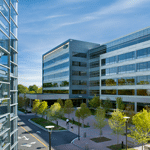The financial imperatives of urban real estate often mean consuming green space with structures. But Jim Cronin of The Bulfinch Companies and ADD, Inc. architect Larry Grossman managed to do the opposite. Home to the new, LEED Gold headquarters of Forrester Research, a global research and advisory firm, the redevelopment of Cambridge Discovery Park outside Boston sets a high bar.
What kind of site was this and how would you describe it now?
Jim Cronin: It was previously occupied by circa-1950s office structures, and yet it’s technically a wetland. The land area—27 acres—and adjacent Alewife Brook Reservation represent the third-largest campus in Cambridge, after Harvard University and the Massachusetts Institute of Technology. At-grade surface parking lots formerly consumed a substantial amount of the open space.
Who decided this would be a LEED building and why?
Cronin: LEED certifications are almost required in new Boston-area commercial construction but not by government mandate. Sustainable structures net better rents and resale values and allow tenant companies to attract better employees. [The Forrester project] was a build-to-suit tenant, so it had substantial input into its final design.
PROJECT
Location Cambridge, MA
Size 820,000 sq ft (when completed)
Program Lab, research and development, office space
Awards GoGreen Award, City of Cambridge for storm-water management design
TEAM
Developer The Bulfinch Companies
Architect ADD Inc.
Client Forrester Research
General Contractor John Moriarty & Associates (base building and tenant build-out)
Engineers AHA Consulting
GREEN
Certification LEED-CS Gold, LEED-CI Platinum
Site Wetland preservation, reduced building footprint
Envelope Tight building envelope to conserve energy
Water Water-efficient landscaping, ponds for rainwater runoff
Energy Highly efficient heating and cooling systems
Landscape Allows seasonal flooding to naturally percolate under structures
What features did Forrester like?
Larry Grossman: The master plan allows for “urban wild” landscaping. Forrester, which occupies Building 200/300, particularly likes the glass curtain on the two-story lobby, which allows a strong visual connection with the outdoors.
Were there special challenges on this project?
Grossman: The development sits on a floodplain alongside the Little River, which flows through Cambridge. We designed all buildings to sit above the high watermark with ponds that take rainwater runoff for natural filtration into the ground, reducing the storm-water load on the city sewer system.
What features did you put into the building to help it achieve LEED Gold certification?
Cronin: The certification is for the Core & Shell, which includes the building envelope and the HVAC mechanical systems. It uses a HEPA filter system in addition to other superior indoor-air-quality systems: low-VOC adhesives, coatings, paints, and sealants. Ninety-six percent of the construction waste was recycled, including the demolition from the previous structures. The landscaping is drought resistant and water-efficient plumbing fixtures are used throughout. Workers are within walking distance of stores and restaurants as well as a commuter train stop. Zipcars are available on-site, and there are electric-car chargers in the garage as well as bike racks. And shuttle buses run to the T-system station.
Are you planning future sustainable projects?
Cronin: As a member of the USGBC, Bulfinch is committed to constructing
LEED-certified structures in the future and has adopted the Building Owners and Managers Association of Boston best practices. That includes a 30-percent reduction in energy consumption, heat island reduction, transportation alternatives, and green cleaning.

